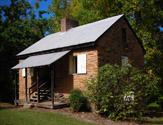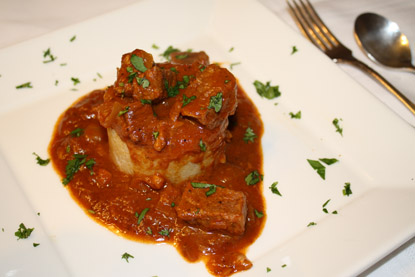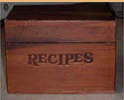















Soul Food
Goulash vs. Grillades
Not too long ago, I made goulash for Malcolm White, a dear friend and fellow food enthusiast. After a couple of bites, he said, "This is just like grillades, and you should serve it with grits." It was an interesting and unexpected comment and, being a staunch Southerner, I felt duty bound to take up any cause related to grits. I had heard of grits and grillades, but I have to admit I did not know a lot about it.
A little research revealed that grits and grillades (pronounced gree-odds and meaning grilled in French) is a very simple New Orleans recipe that is most often enjoyed at breakfast or brunch. The Picayune's Creole Cook Book recipe is pretty simple: beef, a good roux, mirepoix (onions, bell peppers and celery) tomatoes, stock and some herbs. Talk About Good, another old standby cookbook offers a very similar recipe: beef, roux, onion, thyme, parsley and tomatoes. So I think it is safe to say the recipes vary very little. All call for the ingredients to be browned and then cooked slowly for about forty-five minutes, and almost all agree it needs to be done in the ubiquitous black iron skillet.
This seems to be one of those recipes that has general appeal both for the well-heeled and the po' folks, too. The Picayune cookbook is a Creole cookbook (think uptown New Orleans, classy and well-to-do), while Talk About Good is Cajun in nature (think bayous and shrimp boats). These cuisines bare some similarities, but are different in many ways and should not be confused with each other.
There are some variations on this recipe that debate weighty questions. Should one bread it or serve it with or without gravy? To me, if there is any question at all, it should be, "What do I serve it with?" Some suggest hominy, but I am averse to that idea altogether. Others say rice, but most often it is served with grits. I think grits are much more versatile and can be fortified with bits of pork, bacon, onion, hot pepper and cheese and therefore win hands-down in my book. The subject of what can be done with grits is another story in itself and many pages could be written on it, but I'll save that for another time.
But I have to tell you that my recipe for goulash seems much more inviting to me than the grillades described in most cookbooks. Grillades is just a simple beef stew. The spicing is not particularly interesting. There are no contrasting vegetables that might provide more depth. And, while some might be inordinately fond of it, it is not exactly my cup of tea. My apologies to my friends who differ.
Goulash is thought by many to be the national dish of Hungary, and was a favorite of their herdsmen (cowboys), and it is quite simple, too. It consists of beef, onion, paprika, garlic, tomato, a cup of good red wine and caraway seeds. But just the addition of the spicy paprika and the good wine makes all the difference in the world. When you add in the caraway seeds, you've got a real winner. Another big difference is that the onions are meant to bind the whole together, and so the goulash is cooked until the onions disappear completely. That might sound like a subtle difference, but it makes a big difference in flavor and texture.
A little research revealed that grits and grillades (pronounced gree-odds and meaning grilled in French) is a very simple New Orleans recipe that is most often enjoyed at breakfast or brunch. The Picayune's Creole Cook Book recipe is pretty simple: beef, a good roux, mirepoix (onions, bell peppers and celery) tomatoes, stock and some herbs. Talk About Good, another old standby cookbook offers a very similar recipe: beef, roux, onion, thyme, parsley and tomatoes. So I think it is safe to say the recipes vary very little. All call for the ingredients to be browned and then cooked slowly for about forty-five minutes, and almost all agree it needs to be done in the ubiquitous black iron skillet.
This seems to be one of those recipes that has general appeal both for the well-heeled and the po' folks, too. The Picayune cookbook is a Creole cookbook (think uptown New Orleans, classy and well-to-do), while Talk About Good is Cajun in nature (think bayous and shrimp boats). These cuisines bare some similarities, but are different in many ways and should not be confused with each other.
There are some variations on this recipe that debate weighty questions. Should one bread it or serve it with or without gravy? To me, if there is any question at all, it should be, "What do I serve it with?" Some suggest hominy, but I am averse to that idea altogether. Others say rice, but most often it is served with grits. I think grits are much more versatile and can be fortified with bits of pork, bacon, onion, hot pepper and cheese and therefore win hands-down in my book. The subject of what can be done with grits is another story in itself and many pages could be written on it, but I'll save that for another time.
But I have to tell you that my recipe for goulash seems much more inviting to me than the grillades described in most cookbooks. Grillades is just a simple beef stew. The spicing is not particularly interesting. There are no contrasting vegetables that might provide more depth. And, while some might be inordinately fond of it, it is not exactly my cup of tea. My apologies to my friends who differ.
Goulash is thought by many to be the national dish of Hungary, and was a favorite of their herdsmen (cowboys), and it is quite simple, too. It consists of beef, onion, paprika, garlic, tomato, a cup of good red wine and caraway seeds. But just the addition of the spicy paprika and the good wine makes all the difference in the world. When you add in the caraway seeds, you've got a real winner. Another big difference is that the onions are meant to bind the whole together, and so the goulash is cooked until the onions disappear completely. That might sound like a subtle difference, but it makes a big difference in flavor and texture.
Again, we find ourselves back to the question of what it might go best with. In Europe it is most often served with a potato dumpling, and when done right that dumpling is a killer. The Hungarians seem to favor csipetke, a noodle (about the size of a bean) made very simply with eggs, salt and flour. I could make an argument for a wide pasta as a good choice and rice might do in a fix, too, but I have to admit my friend Malcolm was right. Grits seem to make the best connection. The grits will absorb some of the sauce, but will not become too runny unless you take all day to eat it. Grits are pretty simple to make and can be poured into artful forms and make for great presentation.

Goulash & Grits
Here's the basic recipe for goulash and grits. It is good anytime, but is particularly satisfying during the winter months when something warm and sustaining is such a comfort.
Goulash & Grits
4 tablespoons butter
4-6 cloves chopped garlic
2 cups chopped onion
2 pounds cubed top round or other roast
6 ounces tomato paste
1 cup red wine
4-5 cups beef stock
3 tablespoons paprika
2 tablespoons caraway seeds
Zest of 1 lemon
Salt and pepper
1 cup grits
2 tablespoons butter
3-4 tablespoons parmesan cheese
Sauté the garlic and onion in 2 tablespoons of butter for 10 minutes. Season the cubed beef with salt and pepper. Add it to the onions, sautéing for an additional 10 minutes. Add the tomato paste, incorporate well and sauté for 5 minutes, being careful not to let it burn. Add the red wine, simmer for 2-3 minutes and then add the stock. Add the paprika and stir. Mix the caraway seeds and the remaining butter, finely chopping the seeds before adding to the goulash. (The butter binds the caraway seeds so that they can be chopped without ending up all over your kitchen.) Add the zest of one lemon. Simmer the goulash until the onions disappear completely (approximately 45 minutes), and remember to give it an occasional stir.
Prepare the grits according to the package instructions, adding the butter and cheese when done. Pour the grits into a butter mold of your choosing. (I like a small 2 inch round ramekin.) Let sit until cool enough to handle and the grits are firm. Remove gently from mold. Plate the grits and top with the goulash. A garnish of cilantro adds color. Serve with beer, semisweet white wine (Gewurztraminer does well) or some good southern iced tea.
Goulash & Grits
4 tablespoons butter
4-6 cloves chopped garlic
2 cups chopped onion
2 pounds cubed top round or other roast
6 ounces tomato paste
1 cup red wine
4-5 cups beef stock
3 tablespoons paprika
2 tablespoons caraway seeds
Zest of 1 lemon
Salt and pepper
1 cup grits
2 tablespoons butter
3-4 tablespoons parmesan cheese
Sauté the garlic and onion in 2 tablespoons of butter for 10 minutes. Season the cubed beef with salt and pepper. Add it to the onions, sautéing for an additional 10 minutes. Add the tomato paste, incorporate well and sauté for 5 minutes, being careful not to let it burn. Add the red wine, simmer for 2-3 minutes and then add the stock. Add the paprika and stir. Mix the caraway seeds and the remaining butter, finely chopping the seeds before adding to the goulash. (The butter binds the caraway seeds so that they can be chopped without ending up all over your kitchen.) Add the zest of one lemon. Simmer the goulash until the onions disappear completely (approximately 45 minutes), and remember to give it an occasional stir.
Prepare the grits according to the package instructions, adding the butter and cheese when done. Pour the grits into a butter mold of your choosing. (I like a small 2 inch round ramekin.) Let sit until cool enough to handle and the grits are firm. Remove gently from mold. Plate the grits and top with the goulash. A garnish of cilantro adds color. Serve with beer, semisweet white wine (Gewurztraminer does well) or some good southern iced tea.
BIBLIOGRAPHY
The Picayune's Creole Cook Book (New Orleans: Times-Picayune Publishing Company, 1954).
Talk About Good (Lafayette, Louisiana: The Junior League of Lafayette, Inc., 1969).
"Hungarian Goulash," Budapest Tour Guide. Retrieved January 2011: http://www.budapest-tourist-guide.com/hungarian-goulash.html)
https://www.jenreviews.com/hungarian-goulash/
Author: Julian G. Brunt. Published February 15, 2011.
The Picayune's Creole Cook Book (New Orleans: Times-Picayune Publishing Company, 1954).
Talk About Good (Lafayette, Louisiana: The Junior League of Lafayette, Inc., 1969).
"Hungarian Goulash," Budapest Tour Guide. Retrieved January 2011: http://www.budapest-tourist-guide.com/hungarian-goulash.html)
https://www.jenreviews.com/hungarian-goulash/
Author: Julian G. Brunt. Published February 15, 2011.
Copyright
Southern Edition
All Rights Reserved
Southern Edition
All Rights Reserved
All materials contained on this site, including text and images, are protected by copyright laws and may not be reproduced without prior written permission from the publisher. Where applicable, use of some items contained on this site may require permission from other copyright owners.
Fair Use of text from SouthernEdition.com is permitted to the extent allowed by copyright law. Proper citation is requested. Please use this guide when citing a Southern Edition article.
Contact Greg Freeman or SouthernEdition.comFair Use of text from SouthernEdition.com is permitted to the extent allowed by copyright law. Proper citation is requested. Please use this guide when citing a Southern Edition article.
